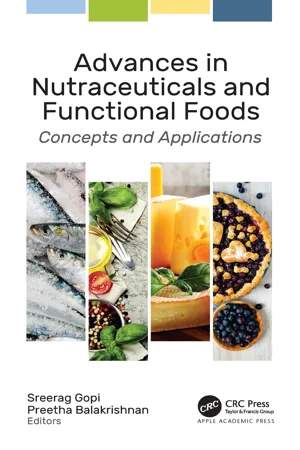
Advances in Nutraceuticals and Functional Foods
Concepts and Applications
Sreerag Gopi, Preetha Balakrishnan, Sreerag Gopi, Preetha Balakrishnan
- 360 páginas
- English
- ePUB (apto para móviles)
- Disponible en iOS y Android
Advances in Nutraceuticals and Functional Foods
Concepts and Applications
Sreerag Gopi, Preetha Balakrishnan, Sreerag Gopi, Preetha Balakrishnan
Información del libro
This book examines the rapidly growing field of functional foods in the prevention and management of chronic and infectious diseases. Chapters explore the varied sources, biochemical properties, metabolics, health benefits, and safety of bioactive ingredients of nutraceutical and functional food products. Special emphasis is given to linking the molecular and chemical structures of biologically active components in foods to their nutritional and pharmacological effects on human health and wellness. In addition to discussing scientific and clinical rationales for different sources of functional foods, the book also explains in detail scientific methodologies used to investigate the functionality, effectiveness, and safety of bioactive ingredients in food.
The chapter authors discuss advanced nanocarriers for nutraceuticals based on structured lipids and nonlipids, nanoparticulate approaches for improved nutrient bioavailability, adulteration and safety issues, nanodelivery systems, microencapsulation, and more. The book discusses some particular health benefits from nutrition nutraceuticals, including probiotic dairy and non-dairy products and bioactive proteins and peptides as functional foods. The volume also gives an overview of emerging trends, growth patterns, and new opportunities in the field of nutraceuticals and functional foods.
Preguntas frecuentes
Información
CHAPTER 1 Introduction to Functional Foods and Nutraceuticals
ABSTRACT
1.1 INTRODUCTION

1.2 FUNCTIONAL FOODS
1.2.1 CONCEPTUAL DEFINITION AND CLASSIFICATION
| Year | Definition of Functional Food | Source/Reference(s) |
|---|---|---|
| 1991 | ‘Foods which are, based on the knowledge between foods or food components and health, expected to have certain health benefits, and have been licensed to bear a label claiming that a person using them for specified health use may expect to obtain the health use through the consumption thereof.’ | FOSHU, Japanese Ministry of Health and Welfare |
| 1994 | ‘Foods that encompass potentially healthful products, including any modified food or food ingredient that may provide a health benefit beyond that of the traditional nutrients it contains.’ | National Academy of Sciences Food and Nutrition Board |
| 1999 | ‘Food which could be regarded as ‘functional’ as being one that has been satisfactorily demonstrated to beneficially affect one or more functions in the body, beyond adequate nutritional effects, in a way which is relevant to either an improved state of health and well-being and/or a reduction of risk. It is consumed as part of a normal food pattern. It is not a pill, a capsule or a... |
Índice
- Cover Page
- Half Title Page
- Title Page
- Copyright Page
- About the Editors
- Table of Contents
- Contributors
- Abbreviations
- Preface
- 1. Introduction to Functional Foods and Nutraceuticals
- 2. Advanced Nanocarriers for Nutraceuticals Based on Structured Lipid and Nonlipid
- 3. Nanoparticulate Approaches for Improved Nutrient Bioavailability
- 4. Adulteration and Safety Issues in Nutraceuticals and Functional Foods
- 5. Nutraceuticals-Loaded Nano-Sized Delivery Systems: Potential Use in the Prevention and Treatment of Cancer
- 6. Nutrition Nutraceuticals: A Proactive Approach for Healthcare
- 7. Bioactive Proteins and Peptides as Functional Foods
- 8. News and Trends in the Development of Functional Foods: Probiotic Dairy and Non-Dairy Products
- 9. Microencapsulation: An Alternative for the Application of Probiotic Cells in the Food and Nutraceuticals Industries
- 10. Nutraceuticals-Based Nano-Formulations: An Overview Through Clinical Validations
- 11. Growth Patterns, Emerging Opportunities, and Future Trends in Nutraceuticals and Functional Foods
- Index